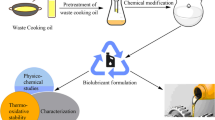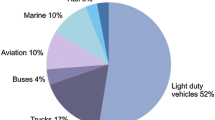Abstract
Poultry waste poses serious environmental and health problems because it emanates offensive odor and promotes fly and rodent breeding. Appropriate utilization of such waste and its by-products can simultaneously prevent side effects and provide an economic advantage. In this study, poultry waste oil and its methyl ester derivatives were converted to biolubricants in a two-step sequential chemical modification process: epoxidation using in situ formed peroxyformic acid and epoxide ring-opening with isoamyl alcohol in the presence of p-toluenesulfonic acid. The biolubricants obtained from the epoxidized chicken waste oil and epoxidized methyl esters by the ring-opening reaction were characterized. The viscosity index and pour point of the biolubricant synthesized from epoxidized chicken waste oil were 111.32 and − 2 °C respectively. It was observed that the pour point of the biolubricant produced for chicken oil is lower compared to the pour point of the biolubricant produced from FAME. However, the lubricants derived from epoxidized methyl esters exhibited slightly higher oxidative stability (18 h). Our results suggest that lubricant synthesized from poultry waste oil can be considered feasible alternative to petroleum-based lubricants as it matches the kinematic viscosity and low-temperature properties of the commercial lubricant ISO VG 32 grade oil.




Similar content being viewed by others
Data availability
The original contributions presented in the study are included in the manuscript; further inquiries can be directed to the corresponding author/s.
References
Abosede EE (2013) Effect of crude oil pollution on some soil physical properties. IOSR J Agric Vet Sci 6:14–17. https://doi.org/10.9790/2380-0631417
Alptekin E, Canakci M (2010) Optimization of pretreatment reaction for methyl ester production from chicken fat. Fuel 89:4035–4039. https://doi.org/10.1016/j.fuel.2010.04.031
Campanella A, Fontanini C, Baltanás MA (2008) High yield epoxidation of fatty acid methyl esters with performic acid generated in situ. Chem Eng J 144:466–475. https://doi.org/10.1016/j.cej.2008.07.016
Canakci M, Sanli H (2008) Biodiesel production from various feedstocks and their effects on the fuel properties. J Ind Microbiol Biotechnol 35:431–441. https://doi.org/10.1007/s10295-008-0337-6
Carole TM, Pellegrino J, Paster MD (2004) Opportunities in the industrial biobased products industry. Appl Biochem Biotech- Part A Enzym Eng Biotechnol 115:871–885. https://doi.org/10.1007/978-1-59259-837-3_71
Díaz-Rodríguez A, Davis BG (2011) Chemical modification in the creation of novel biocatalysts. Curr Opin Chem Biol 15:211–219. https://doi.org/10.1016/j.cbpa.2010.12.002
do Valle CP, Rodrigues JS, Fechine LMUD, Cunha AP, QueirozMalveira J, Luna FMT, Ricardo NMPS (2018) Chemical modification of Tilapia oil for biolubricant applications. J Clean Prod 191:158–166. https://doi.org/10.1016/j.jclepro.2018.04.062
Encinar JM, Nogales-Delgado S, Sánchez N, González JF (2020) Biolubricants from rapeseed and castor oil transesterification by using titanium isopropoxide as a catalyst: Production and characterization. Catalysts 10. https://doi.org/10.3390/catal10040366
Hernandez M, Meza Gordillo R, Torrestiana-Sánchez B, Rosales-Quintero A, Ventura-Canseco L, Castañon H (2016) Chicken fat and biodiesel viscosity modification with additives for the formulation of biolubricants. Fuel 198https://doi.org/10.1016/j.fuel.2016.12.039
Huang J, Yang P, Guo Y, Zhang K (2011) Electricity generation during wastewater treatment: an approach using an AFB-MFC for alcohol distillery wastewater. Desalination 276:373–378. https://doi.org/10.1016/j.desal.2011.03.077
Inkerd R, Dussadee N, Thararux C, Chanathaworn J, Ramaraj R (2015) An experimental investigation of palm oil as an environment friendly biolubricant, in: The 22nd Tri-U International Joint Seminar and Symposium At: Jiangsu University, China.
Jain A, Suhane A (2012) Review Article “Research approach & prospects of non edible vegetable oil as a potential resource for biolubricant - a review.”
Janković MR, Govedarica OM, Sinadinović-Fišer SV (2020) The epoxidation of linseed oil with in situ formed peracetic acid: a model with included influence of the oil fatty acid composition. Ind Crops Prod 143:111881. https://doi.org/10.1016/j.indcrop.2019.111881
Ju Y-H, Sari N, Go A, Wang M-J, Agapay R, Ayucitra A (2020) Preparation of epoxidized fatty acid ethyl ester from tung oil as a bio-lubricant base-stock. Waste Biomass Valoriz 11. https://doi.org/10.1007/s12649-019-00749-z
Kalam MA, Masjuki HH, Cho HM, Mosarof MH, Mahmud MI, Chowdhury MA, Zulkifli NWM (2017) Influences of thermal stability, and lubrication performance of biodegradable oil as an engine oil for improving the efficiency of heavy duty diesel engine. Fuel 196:36–46. https://doi.org/10.1016/j.fuel.2017.01.071
Khot SN, Lascala JJ, Can E, Morye SS, Williams GI, Palmese GR, Kusefoglu SH, Wool RP (2001) Development and application of triglyceride-based polymers and composites. J Appl Polym Sci 82:703–723. https://doi.org/10.1002/app.1897
Liu T, Fang L, Zhang X (2015) Preparation of a kind of reactive pour point depressant and its action mechanism. Fuel 143:448–454. https://doi.org/10.1016/j.fuel.2014.11.094
M, WM, Suzzy C. Ho, TRF (2006) Synthetic lubricant base stock process and products. PractAdv Pet Process. https://doi.org/10.1007/978-0-387-25789-1
Masudi A, Muraza O (2018) Vegetable oil to biolubricants: review on advanced porous catalysts. Energy Fuels 32:10295–10310. https://doi.org/10.1021/acs.energyfuels.8b02017
Mathiarasi R, Partha N (2015) Production and characterization of biodiesel from Thevetia neriifolia Juss oil. Energy Source Part A: Recovery Util Environ Effects 37:2737–2744. https://doi.org/10.1080/15567036.2012.722745
Mohanty AK, Misra M, Drzal LT (2002) Sustainable bio-composites from renewable resources: opportunities and challenges in the green materials world. J Polym Environ 10:19–26. https://doi.org/10.1023/A:1021013921916
Nowak P, Kucharska K, Kamiński M (2019) Ecological and health effects of lubricant oils emitted into the environment. Int J Environ Res Public Health 16:1–13. https://doi.org/10.3390/ijerph16163002
Owuna FJ, Dabai MU, Sokoto MA, Dangoggo SM, Bagudo BU, Birnin-Yauri UA, Hassan LG, Sada I, Abubakar AL, Jibrin MS (2020) Chemical modification of vegetable oils for the production of biolubricants using trimethylolpropane: a review. Egypt J Pet 29:75–82. https://doi.org/10.1016/j.ejpe.2019.11.004
Paul AK, Borugadda VB, Goud VV (2021) In-situ epoxidation of waste cooking oil and its methyl esters for lubricant applications: characterization and rheology. Lubricants 9:1–14. https://doi.org/10.3390/lubricants9030027
Rahman MH, Warneke H, Webbert H, Rodriguez J, Austin E, Tokunaga K, Rajak DK, Menezes PL (2021) Water-based lubricants: development, properties, and performances. Lubricants 9. https://doi.org/10.3390/lubricants9080073
Reeves CJ, Siddaiah A, Menezes PL (2017) A review on the science and technology of natural and synthetic biolubricants. J Bio- Tribo-Corros 3:1–27. https://doi.org/10.1007/s40735-016-0069-5
Regueira T, Lugo L, Fandiño O, López ER, Fernández J (2011) Compressibilities and viscosities of reference and vegetable oils for their use as hydraulic fluids and lubricants. Green Chem 13:1293–1302. https://doi.org/10.1039/c0gc00597e
Salimon J, Salih N (2010) Modification of epoxidized ricinoleic acid for biolubricant base oil with improved flash and pour points. Asian J Chem 22:5468–5476
Salimon J, Salih N, Yousif E (2012) Improvement of pour point and oxidative stability of synthetic ester basestocks for biolubricant applications. Arab J Chem 5:193–200. https://doi.org/10.1016/j.arabjc.2010.09.001
Salimon J, Salih N, Yousif E (2012) Triester derivatives of oleic acid: the effect of chemical structure on low temperature, thermo-oxidation and tribological properties. Ind Crops Prod 38:107–114. https://doi.org/10.1016/j.indcrop.2012.01.019
Salimon J, Salih N, Yousif E (2010) Biolubricants: raw materials, chemical modifications and environmental benefits. Eur J Lipid Sci Technol 112:519–530. https://doi.org/10.1002/ejlt.200900205
Sangkharak K, Mhaisawat S, Rakkan T, Paichid N, Yunu T (2020) Utilization of mixed chicken waste for biodiesel production using single and combination of immobilized lipase as a catalyst. Biomass Conv Biorefin. https://doi.org/10.1007/s13399-020-00842-7
Sharma RV, Somidi AKR, Dalai AK (2015) Preparation and properties evaluation of biolubricants derived from canola oil and canola biodiesel. J Agric Food Chem 63:3235–3242. https://doi.org/10.1021/jf505825k
Soni S, Agarwal M (2014) Lubricants from renewable energy sources – a review. Green Chem Lett Rev 7:359–382. https://doi.org/10.1080/17518253.2014.959565
Syahir AZ, Zulkifli NWM, Masjuki HH, Kalam MA, Alabdulkarem A, Gulzar M, Khuong LS, Harith MH (2017) A review on bio-based lubricants and their applications. J Clean Prod 168:997–1016. https://doi.org/10.1016/j.jclepro.2017.09.106
Turco R, Tesser R, Russo V, Cogliano T, Di Serio M, Santacesaria E (2021) Epoxidation of linseed oil by performic acid produced in situ. Ind Eng Chem Res 60:16607–16618. https://doi.org/10.1021/acs.iecr.1c02212
Xu Y-Q, Qu J-P (2009) Mechanical and rheological properties of epoxidized soybean oil plasticized poly(lactic acid). J Appl Polym Sci - J APPL POLYM SCI 112:3185–3191. https://doi.org/10.1002/app.29797
Author information
Authors and Affiliations
Contributions
G. Akbar Basha and D. Harish performed the experiments and preparation of manuscript; R. Saranya, C. Chandrasatheesh, and J. Jayapriya developed concept, designed the experiments, and supervised all the experimental works, data analysis, and in write up of the manuscript. All authors read and approved the final manuscript.
Corresponding author
Ethics declarations
Conflict of interest
The authors declare no competing interests.
Additional information
Publisher's note
Springer Nature remains neutral with regard to jurisdictional claims in published maps and institutional affiliations.
Rights and permissions
About this article
Cite this article
Basha, G.A., Harish, D., Saranya, R. et al. Biolubricants derived from poultry waste oil and its methyl esters by epoxidation and epoxide ring-opening—a comparative study. Biomass Conv. Bioref. 14, 2621–2628 (2024). https://doi.org/10.1007/s13399-022-02771-z
Received:
Revised:
Accepted:
Published:
Issue Date:
DOI: https://doi.org/10.1007/s13399-022-02771-z




